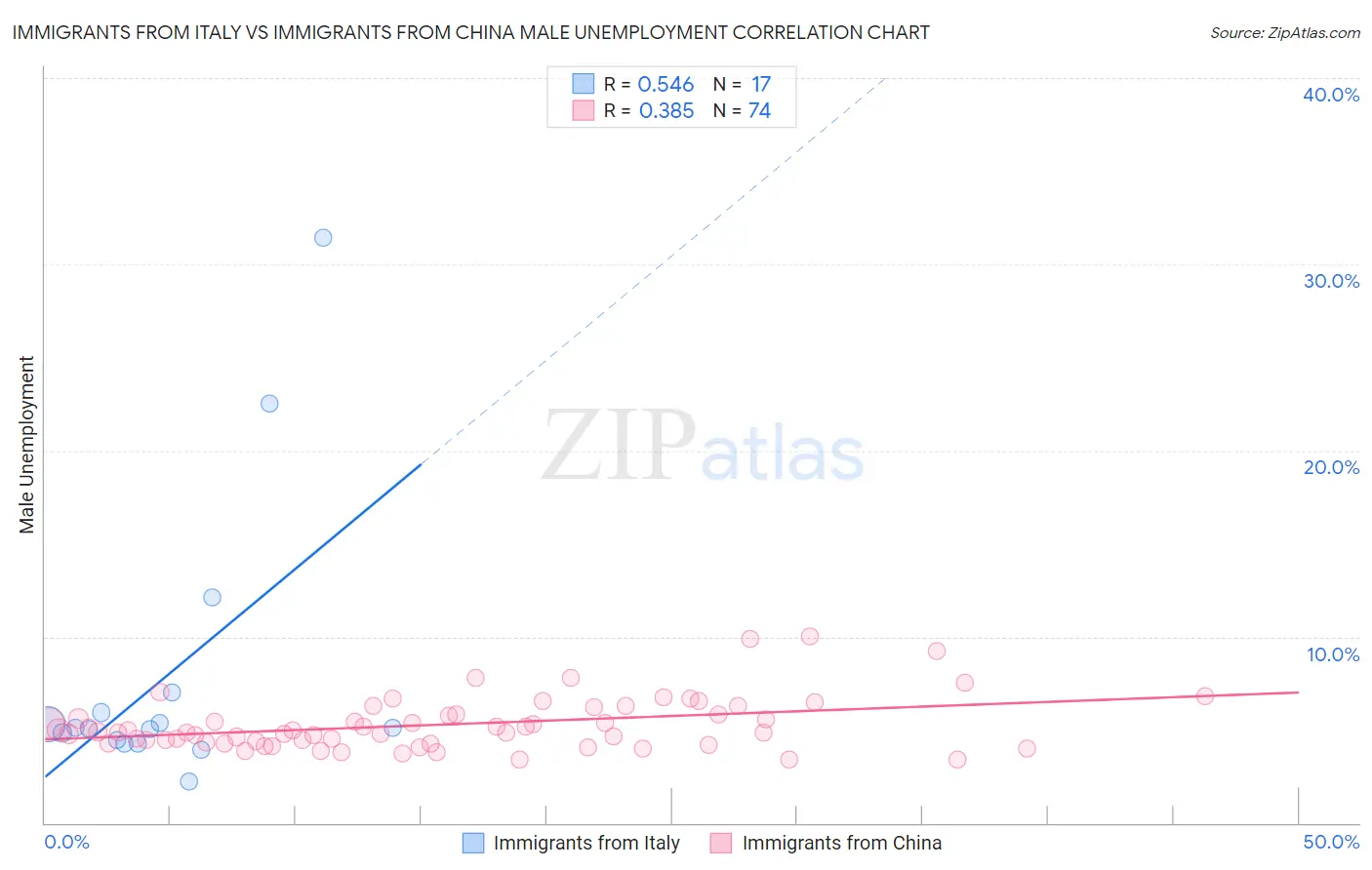Immigrants from Italy vs Immigrants from China Male Unemployment
COMPARE
Immigrants from Italy
Immigrants from China
Male Unemployment
Male Unemployment Comparison
Immigrants from Italy
Immigrants from China
5.2%
MALE UNEMPLOYMENT
76.3/ 100
METRIC RATING
148th/ 347
METRIC RANK
5.2%
MALE UNEMPLOYMENT
70.6/ 100
METRIC RATING
161st/ 347
METRIC RANK
Immigrants from Italy vs Immigrants from China Male Unemployment Correlation Chart
The statistical analysis conducted on geographies consisting of 323,258,281 people shows a substantial positive correlation between the proportion of Immigrants from Italy and unemployment rate among males in the United States with a correlation coefficient (R) of 0.546 and weighted average of 5.2%. Similarly, the statistical analysis conducted on geographies consisting of 454,688,998 people shows a mild positive correlation between the proportion of Immigrants from China and unemployment rate among males in the United States with a correlation coefficient (R) of 0.385 and weighted average of 5.2%, a difference of 0.43%.

Male Unemployment Correlation Summary
| Measurement | Immigrants from Italy | Immigrants from China |
| Minimum | 2.2% | 3.4% |
| Maximum | 31.4% | 10.0% |
| Range | 29.2% | 6.6% |
| Mean | 7.9% | 5.3% |
| Median | 5.1% | 4.9% |
| Interquartile 25% (IQ1) | 4.4% | 4.3% |
| Interquartile 75% (IQ3) | 6.5% | 5.9% |
| Interquartile Range (IQR) | 2.1% | 1.5% |
| Standard Deviation (Sample) | 7.6% | 1.4% |
| Standard Deviation (Population) | 7.4% | 1.4% |
Demographics Similar to Immigrants from Italy and Immigrants from China by Male Unemployment
In terms of male unemployment, the demographic groups most similar to Immigrants from Italy are Immigrants from Europe (5.2%, a difference of 0.010%), Indian (Asian) (5.2%, a difference of 0.030%), Slovak (5.2%, a difference of 0.060%), Immigrants from Burma/Myanmar (5.2%, a difference of 0.10%), and Immigrants from Kenya (5.2%, a difference of 0.11%). Similarly, the demographic groups most similar to Immigrants from China are Immigrants from Norway (5.2%, a difference of 0.030%), Indonesian (5.2%, a difference of 0.040%), Immigrants from Indonesia (5.2%, a difference of 0.070%), Immigrants from Northern Africa (5.2%, a difference of 0.12%), and American (5.2%, a difference of 0.15%).
| Demographics | Rating | Rank | Male Unemployment |
| Sri Lankans | 77.9 /100 | #144 | Good 5.2% |
| Macedonians | 77.7 /100 | #145 | Good 5.2% |
| Immigrants | Kenya | 77.6 /100 | #146 | Good 5.2% |
| Immigrants | Burma/Myanmar | 77.5 /100 | #147 | Good 5.2% |
| Immigrants | Italy | 76.3 /100 | #148 | Good 5.2% |
| Immigrants | Europe | 76.2 /100 | #149 | Good 5.2% |
| Indians (Asian) | 76.0 /100 | #150 | Good 5.2% |
| Slovaks | 75.5 /100 | #151 | Good 5.2% |
| Egyptians | 74.8 /100 | #152 | Good 5.2% |
| Immigrants | Uruguay | 73.9 /100 | #153 | Good 5.2% |
| Laotians | 73.8 /100 | #154 | Good 5.2% |
| Immigrants | Hungary | 73.4 /100 | #155 | Good 5.2% |
| Americans | 72.7 /100 | #156 | Good 5.2% |
| Immigrants | Northern Africa | 72.3 /100 | #157 | Good 5.2% |
| Immigrants | Indonesia | 71.5 /100 | #158 | Good 5.2% |
| Indonesians | 71.2 /100 | #159 | Good 5.2% |
| Immigrants | Norway | 71.0 /100 | #160 | Good 5.2% |
| Immigrants | China | 70.6 /100 | #161 | Good 5.2% |
| Immigrants | Egypt | 65.9 /100 | #162 | Good 5.2% |
| Immigrants | Hong Kong | 65.7 /100 | #163 | Good 5.2% |
| Afghans | 62.0 /100 | #164 | Good 5.3% |